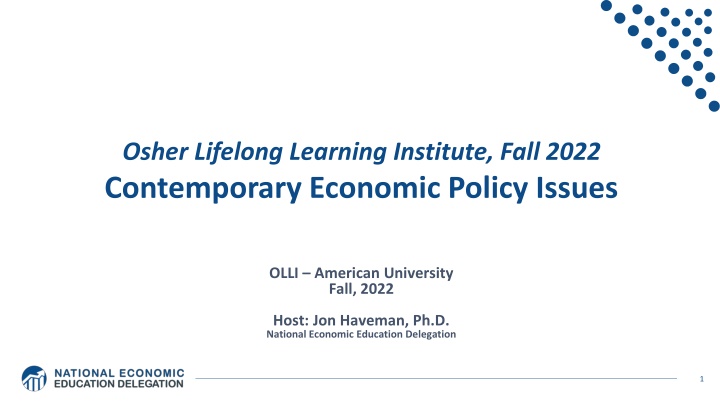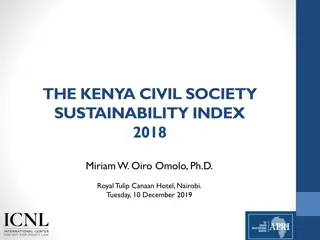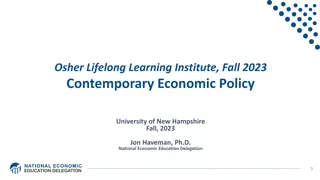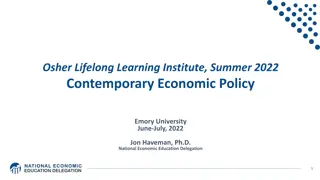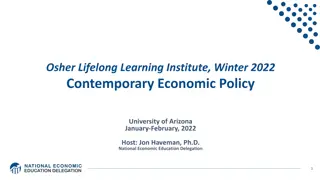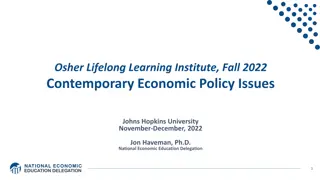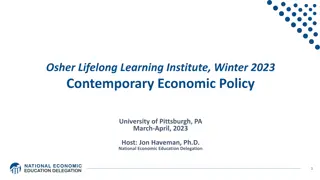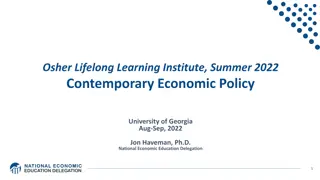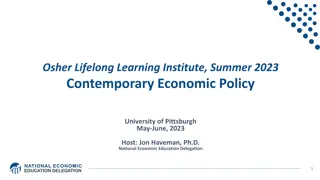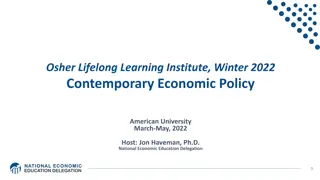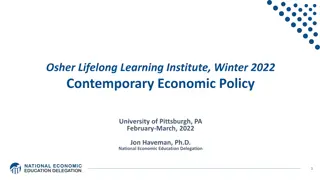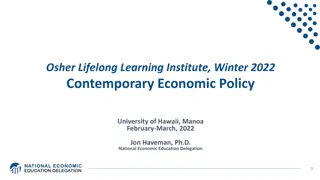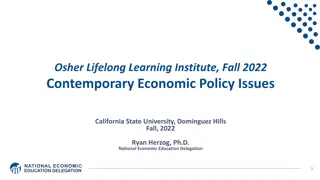Contemporary Economic Policy Issues at Osher Lifelong Learning Institute
Delve into contemporary economic policy topics like US economy, healthcare economics, climate change, and more in this fall 2022 course at Osher Lifelong Learning Institute. Explore trade deficits, exchange rates, and their impact on the economy, taught by experts in the field.
Download Presentation

Please find below an Image/Link to download the presentation.
The content on the website is provided AS IS for your information and personal use only. It may not be sold, licensed, or shared on other websites without obtaining consent from the author.If you encounter any issues during the download, it is possible that the publisher has removed the file from their server.
You are allowed to download the files provided on this website for personal or commercial use, subject to the condition that they are used lawfully. All files are the property of their respective owners.
The content on the website is provided AS IS for your information and personal use only. It may not be sold, licensed, or shared on other websites without obtaining consent from the author.
E N D
Presentation Transcript
Osher Lifelong Learning Institute, Fall 2022 Contemporary Economic Policy Issues OLLI American University Fall, 2022 Host: Jon Haveman, Ph.D. National Economic Education Delegation 1
Available NEED Topics Include: US Economy Immigration Economics Healthcare Economics Housing Policy Climate Change Federal Budgets Economic Inequality Federal Debt Economic Mobility Black-White Wealth Gap Trade and Globalization Autonomous Vehicles Minimum Wages US Social Policy 2
Course Outline Contemporary Economic Policy - Week 1 (9/23): Economic Update (Jon Haveman, NEED) - Week 2 (9/30): Trade and Globalization (Alan Deardorff, University of Michigan) - Week 3 (10/7): Autonomous Vehicles (Jon Haveman, NEED) - Week 4 (10/14): Climate Change Economics (Sarah Jacobson, Williams College) - Week 5 (10/21): The Federal Debt (Joseph Carolan, Oakland University) - Week 6 (10/28): Trade Deficit and Exchange Rates (Alan Deardorff, Univ. of Michigan) 3
Submitting Questions Please submit questions of clarification in the chat. - I will try to handle them as they come up. We will do a verbal Q&A once the material has been presented. OLLI allowing, we can stay beyond the end of class to have further discussion. Slides will be available from the NEED website tomorrow (https://needelegation.org/delivered_presentations.php) 4
Trade Deficits and Exchange Rates Alan Deardorff University of Michigan 5
US Trade Balance = Exports minus Imports Bush Clinton Obama Trump Biden Note the zero. This whole thing is negative a trade deficit! and getting mostly larger since 1992. Recessions 6
Outline The trade deficit - How it s defined - How it has changed over time, US and other - What it means and does not mean Exchange rates - What they are - How they are determined - How they have changed over time, US and other - How they matter - Currency manipulation (if time allows) 8
Trade Deficit The trade balance - Defined as Exports minus Imports, X M - May be reported for goods only, or for goods and services When trade balance is negative, that s a trade deficit - Thus trade deficit is Imports minus Exports, M X The US: - Has had a deficit for many decades - It has grown substantially in recent years - Has had a surplus for trade in services 9
Services trade examples: Professional (legal, engineering, accounting) Banking Computer Construction Logistics US Trade Balances Services Only Goods and Services Goods Only 11
Trade Deficit For the World as a Whole - Since one country s imports are another s exports The sum of all deficits and surpluses must be zero Therefore US deficit implies rest of world has surplus But many countries have deficits 12
Source: Reddit 13
Trade Balances Over Time Trade Balances US and Its Top 5 Trading Partners $billions 600 China 400 Germany Japan 200 0 2004 1970 1972 1974 1976 1978 1980 1982 1984 1986 1988 1990 1992 1994 1996 1998 2000 2002 2006 2008 2010 2012 2014 2016 2018 2020 -200 Canada -400 Mexico -600 -800 US Source: IMF International Financial Statistics -1000 US Canada Mexico China Japan Germany 14
Trade Balances Over Time But note the recent data for Germany: Negative for first time since 1991 Source: WSJ, 7/11/22 15
Trade Deficit What a trade deficit means - Imports > Exports - The gap must be paid for somehow. By o Capital inflows (borrowing, sale of stocks & bonds) o Sale of property (real estate, companies) o Gifts from foreigners (not relevant for US) o Others willing to hold more or our currency (very relevant for US) - What explains the gap? Look at GDP (Gross Domestic Product), which measures both production and income in a country: GDP = C + I + G + X M 16
What a Trade Deficit Means Production GDP = C + I + G + X M Consumption = Household spending Imports (Subtracted because C, I, and G all include imports) Investment = Business spending on equipment and inventories (not inputs) Exports Government = Purchases by government at all levels 17
What a Trade Deficit Means Expenditure Trade Balance Income GDP = C + I + G + X M OR: Expenditure Trade Balance Income X M = GDP (C + I + G) Therefore - Trade Surplus = Income minus Expenditure - Trade Deficit = Expenditure minus Income Running a trade deficit means we are spending more than our income 18
What a Trade Deficit Means For another interpretation, subtract net taxes from both sides T = Net Taxes = Taxes Transfers GDP T = C + I + G T + X M (GDP T C) + (T G) I= (X M) Private Saving Trade Balance Gov t Saving Total Saving 19
What a Trade Deficit Means For another interpretation, subtract net taxes from both sides T = Net Taxes = Taxes Transfers GDP T = C + I + G T + X M (GDP T C) + (T G) I= (X M) 20 Private Saving Trade Balance Gov t Saving Total Saving Trade Balance = Saving minus Investment 20
What a Trade Deficit Means Trade Balance = Saving minus Investment Therefore - If a country is saving more than needed to finance domestic investment, it will, by definition, run a trade surplus - If a country is saving less than needed to finance domestic investment, it will, by definition, run a trade deficit That gap is also, as before, the difference between total income and total expenditure It therefore also appears as - Net borrowing and lending - Plus net acquisition or sales of assets 21
What a Trade Deficit Does NOT Mean There are several very popular interpretations of trade deficits that are not valid, even though many politicians believe them: - That foreign trade barriers are hurting our exports - That other countries are engaged in unfair trade - That our firms are not competitive - That we are losing jobs to other countries - That we need to restrict trade To understand why these are wrong, think about whether they could change - Expenditure relative to income, or - Saving relative to investment Possible exception: If we are in recession and these may change income - But note that trade deficit typically falls during recession, due to recession reducing expenditure 22
US Trade Balance: Goods and Services Note that we may be in a recession now. Recessions 23
US Trade Deficit The US trade deficit means that the US is spending more than its income. How much? - $861 billion in 2021, according to the IMF - How does that compare to US GDP? GDP was $23 trillion. - So US trade deficit was about 3.7% of US GDP - Collectively, we and our government are spending almost 4% above our income. - How does that compare to other countries? 24
Trade Balance / GDP of US and It s Top Ten Trading Partners, 2019 US = 2.7% (grew to 3.7% in 2021) Trade w US $ billions Canada 619.0 Mexico 617.7 China 579.1 Japan 221.6 Germany 189.7 S. Korea 136.8 Source: IMF International Financial Statistics UK 133.2 France 97.2 India 94.3 Italy 82.5 -4.0% -2.0% 0.0% 2.0% 4.0% 6.0% 8.0% 25
Trade Balance / GDP Sample countries, 2019 Singapore 36.9 % Ireland 12.4% Switzerland 9.8% Germany 5.7% China 0.9% Japan 0.2% US 2.7% Romania 4.1% Source: IMF International Financial Statistics Ukraine 8.1% Philippines 9.6% Haiti 24.5% Guyana 62.2% 26
US Trade Deficit Is it a problem? - Yes, if others are unwilling to lend to us or to hold our assets (& our money) - But US, at least for now, has both a strong currency and a strong economy o Others trust assets in the US more than others o They also rely on US dollars for transactions and reserves o We have an Exorbitant Privilege because of the US dollar s role in the world economy (said by Valery Giscard d'Estaing in the 1960s) when most currencies were pegged to dollars, but still valid today) 27
US Trade Deficit Is it a problem? - It does mean that US net debt to foreigners grows every year. - What if other countries decide to dump their dollar assets? Their value would plumet and they would lose. (But runs on currencies, like runs on banks, do happen.) - US net international investment position recently reached $18 trillion! 28
US Net International Investment Position With US population 332 million, that s over $50,000 per person, or about twice that per household. 29
US Trade Deficit Is it a problem? - Yes, in my view, but not because it might hurt us. Because it takes advantage of others. - The US, one of the richest countries in the world, is o Spending more than its income o Being funded, in part, by much poorer countries - We are enjoying o More goods and services than we produce o Produced by often lower-wage and poorer workers abroad o Without, at least in the foreseeable future, paying for them - That just feels wrong to me, o Especially if others are financing us not by choice but because they have no other option. 30
US Trade Deficit Could a trade deficit ever hurt us? - Yes, if we are in a recession. - Then by demanding foreign goods and services instead of our own, we support jobs abroad instead of at home - That is when using trade policy and/or exchange-rate policy to promote demand and higher employment at home seems to make sense. o But it helps us only at the expense of others, if they are also in recession o And it is likely to cause retaliation, cancelling all or more than any benefit 31
Trade Deficits and Exchange Rates Do exchange rates matter for trade deficits? - Yes. - If your currency falls in value, it makes o Exports cheaper o Imports more expensive o Lowers real income and therefore expenditure o Result: Trade balance improves Deficit shrinks, or Surplus grows - Example: Volker policy in 1980-81 o Raised US interest rates Attracted capital from abroad Caused the US dollar to rise in value by about 50% Hurt US exports, helped imports, and increased the US trade deficit 32
Pause Pause for -Questions -5-Minute Break Next: Exchange Rates 33
Exchange Rates What they are - The price of one currency in terms of another - Thus, for example o The number of dollars you pay for one euro: $/ o Or, the number or euros you ll get for one dollar: /$ - Rates reported in data are those between major banks - Rates you see in banks, stores, and currency exchanges will be worse for you o To cover cost and make profit for them 34
Exchange Rates What they are - Confusing! Hard to know what is up and what is down o i.e., The Japanese yen rose today from 95 to 90 o Makes sense because the numbers are understood to be /$, not $/ , so the change from 95 to 90 is in fact a rise in the value of the yen - Yen is reported that way because alternative would be o The Japanese yen rose today from $0.0105 to $0.0111 - For currencies worth much less than $1, scales often show currency/$ o Graphs of rates over time may be drawn on an inverted scale o Or strength may appear as drop on the graph 35
Russias Surprising Economic Headache: A Strong Ruble Wall Street Journal June 29, 2022 36
Russias rouble is now stronger than before the war The Conversation June 13, 2022 37
What Determines Exchange Rates Exchange rates are determined in markets Thus they respond to changes in demand and supply 38
What Determines Exchange Rates Main sources of demand for our country s currency Increases that cause our currency to rise (or appreciate ): - Exports, i.e., foreign purchases of our o Goods o Services - Capital inflows, i.e., foreign purchases of our o Stocks o Bonds o Currency 39
What Determines Exchange Rates Main sources of supply of our country s currency Increases that cause our currency to fall (or depreciate ): - Imports, i.e., our purchases of foreign o Goods o Services - Capital outflows, i.e., our purchases of foreign o Stocks o Bonds 40
What Determines Exchange Rates Changes that cause our currency, the $, to rise in value - More US exports and/or less US imports - Rise in US interest rates and or fall in foreign interest rates - New expectation that dollar will rise o Causes wealth holders to buy more of $ assets - Central banks choose to hold more $ in reserves Opposites of above cause the $ to fall 41
What Determines Exchange Rates Historic Roles of Governments and Central Banks - Define the value of currency in terms of gold or silver o The Gold Standard of the 19th and early 20th century - Intervene in markets to peg their currency to another o The Dollar Standard of 1945-1973 Most currencies were pegged to the US $ Other central Banks bought and sold dollars to achieve this. - Let major currencies float since 1973 o Many weaker countries still intervene in markets, buying or selling to Peg to another currency Reduce currency fluctuations o A few intervene in markets to manipulate their currencies Reduce their value to encourage exports 42
How Have Exchange Rates Changed We ll look at - US dollar - France, Germany, Italy, and Euro Area s euro - Canadian dollar - Mexican peso - British pound - Japanese yen - Chinese renminbi 43
US Exchange Rate Trade-Weighted Dollar Index (Nominal) 140 120 100 80 60 40 20 0 44
US Exchange Rate Dollar rose due to Volker Interest rate rise, fighting inflation. Caused severe recession in US. 45
US Exchange Rate Source: WSJ, 7/11/22 46
Dollar Value of Other Currencies France, Germany, Italy: Before euro US Dollar Value, 1950-1998 Rates floating 0.80 Germany Rates pegged to US$, with only occasional changes 0.70 0.60 0.50 0.40 France 0.30 Italy s currency, the lira, was worth less than 1/10 of a cent 0.20 Source: IMF International Financial Statistics 0.10 0.00 1971 1950 1953 1956 1959 1962 1965 1968 1974 1977 1980 1983 1986 1989 1992 1995 1998 France Germany Italy 47
Euro Area 48
Dollar Value of Other Currencies France, Germany, Italy + Euro US Dollar Value 3.5 Italy Rates here are scaled up to match value of euro in 1998. In preparation for the common currency, countries sought to get their currencies to move together 3 2.5 2 France Euro Area 1.5 1 Source: IMF International Financial Statistics Germany 0.5 0 1974 2002 1950 1954 1958 1962 1966 1970 1978 1982 1986 1990 1994 1998 2006 2010 2014 2018 Euro Area France Germany Italy 49
Dollar Value of Other Currencies July 14, 2022 50
